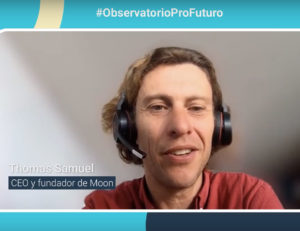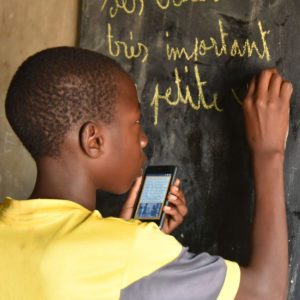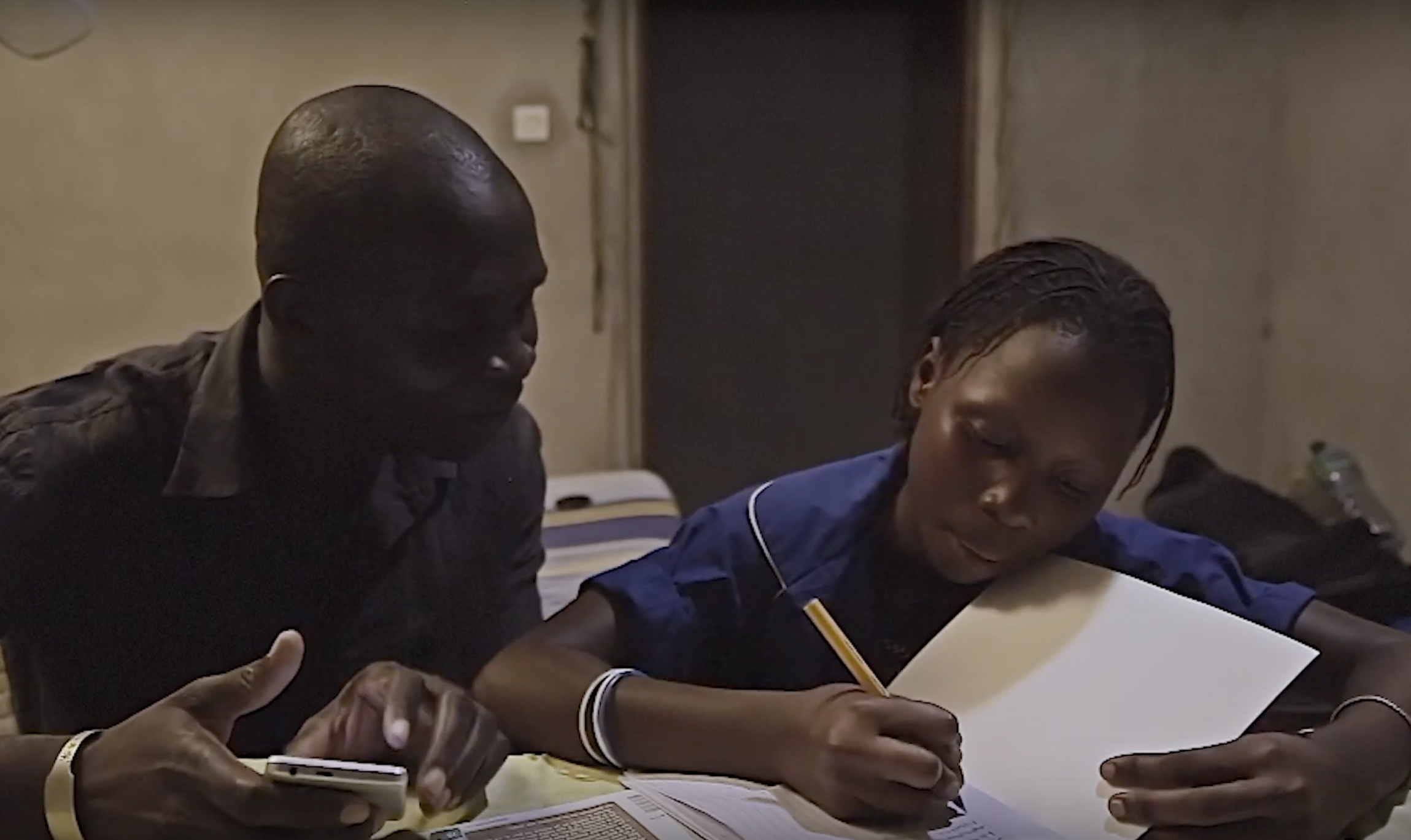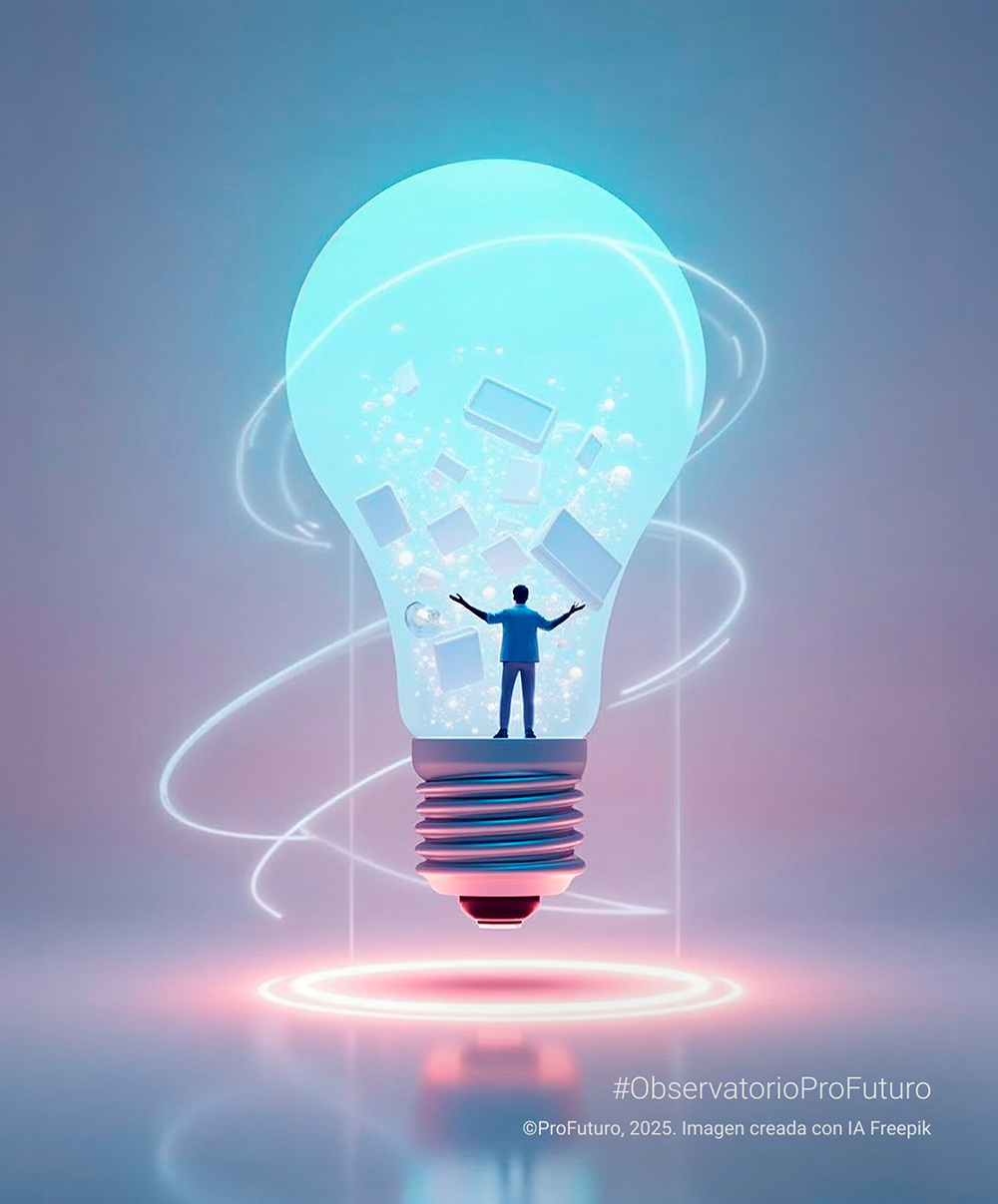
Thomas Samuel, Moon CEO, during the interview.
How does Moon work and how does it carry out its mission?
Moon is a social enterprise that provides digital and financial inclusion along with energy to rural communities. Basically, we sell a pay-as-you-go solar energy system, which includes a smartphone with pre-installed content that allows people to find a way out of poverty, learn and connect through these devices. We have a “door-to-door” sales team and we sell a solar energy system to people who are currently off the grid and not digitalised. It works with a panel connected to a battery, which in turn has several USB ports which up to five lamps can be connected to; and along with this system, we include a special smartphone, which comes pre-loaded with digital content, adapted to the needs of the population. This phone is also sold on a prepaid basis. Both products are paid for by instalments, through the mobile phone itself, which, in a way, also provides them with financial inclusion.
How did you get started? What was the origin of Moon? How did you come up with the idea?
I first set up a street lighting company called Sunna Design, through which we carried out large projects all over the world. In Africa, we had the opportunity to take on an electrical supply project, with solar-powered street lighting. And one day it occurred to me to take my project to a remote part of Senegal, near its border with Mali. That’s when I saw those villages, with street lighting, but nothing else. And that was the beginning of the “pay-as-you-go” solar energy. We thought there would be opportunities, people willing to pay for electricity so we designed a solution, called a “nano-grid”, through which we gave access to pre-paid lighting, distributing energy to nearby houses through solar-powered streetlamps. The pilot project was a success and provided us with an important learning experience: we realised that once they had electricity, people exchanged their old mobile phones for smartphones. There is a clear link between the availability of electricity and the use of smartphones. From there we thought: “Let’s simplify the solution, let’s sell a solar-powered home system plus a smartphone”, and we found a great combination and a good adaptation to the market.
Why do you think energy and digital inclusion is so important in the education sector today?
These people live in a vicious cycle of poverty and it is therefore very important to provide them with energy and digital inclusion. When you have no energy, you can’t save money, you literally burn your money every day: burning kerosene, burning candles… and this is not only bad for your health and for the environment, it is also expensive. Using a solar-powered energy system, paid for in instalments is cheaper for these households and it also allows them to charge a smartphone, thus providing a great complement to energy: access to education, access to social networks, which is a great way to connect with people, with the diaspora… And, of course, all this gives them access to financial resources because paying in instalments creates a credit rating and then allows them to enter a world in which they can get better products and pay for them gradually over time.

Picture: Moon Project.
You have been working in Senegal for many years. In terms of education, what’s the situation like there? What difficulties do children face?
Children face lots of difficulties in these areas. The main one is that they have no light in the house, which is the first thing we resolve. As we have said, when you have no light at home, you study with a candle or a kerosene lamp. Studying like this is very difficult and bad for your eyesight. The second problem is even more complicated: teachers don’t want to go to these areas with no electricity. They don’t want to live in remote and disconnected places. Consequently, we find a deficit or lack of good quality education in those places, purely because teachers are not motivated to want to work there. We have seen how a large proportion of our customers and first users are teachers because, first, they want to have light (this is very important, of course); and they also want to have a smartphone, which allows them to prepare their lessons, and also to train themselves. In our ideal future, once we gain deep penetration in some places, both teachers and children will have full access to energy and, through it, new digital ways of learning and continuing their education.
What are the figures to date? How many people in the world live without access to electricity?
Currently, depending on the country, between 50% and 70% of households live without access to electricity, which is a total of 600 million people. Imagine how many children live in these areas without access to a proper education.
Knowing this data, do you think that digital education, which obviously needs electricity, can be implemented with solutions like yours?
We are convinced that digital education can happen in Africa, even earlier than elsewhere. Africa is a land of opportunity. In some ways, due to the lack of infrastructure, some conventional solutions are really complicated to implement. Electricity is a very good example: from having nothing, they have gone straight to decentralised solar-powered energy. Without going through the huge costs that we have gone through elsewhere, with a centralised system, very heavy infrastructure and everything that goes with it. So, there has been a huge leap. The same is true for telephones. They have gone from having nothing, straight to mobile phones. Without going through the landline infrastructure. And I think the education scenario may be the same: that due to the lack of other alternatives, the adoption may be faster and more effective in some parts of Africa than it has been elsewhere. That’s why we are happy to be working in this field.
How many people are already using Moon in Africa?
We started very recently with a pilot operation in the south of Senegal… To date we have deployed around 7,000 kits that have had an impact on more than 20,000 people. So I’m very proud of these results; it’s been an excellent start. We are now in a position to expand into other parts of Senegal and we are already starting in Togo, where we also have a great potential to change the lives of many people.
Which digital services are most in demand by customers? Are they more related to mobile banking, education…?
80% of our customers have never owned a smartphone before and therefore their digital demands and needs are still unclear, because they don’t realise the potential of the phone yet. So, on the one hand, we organise training sessions to learn how to use a smartphone and the content we pre-install for them, and on the other hand, we monitor what they are using. Of course, social media and mobile banking applications are widely used, and we have also seen a lot of interest in very simple but high-impact applications, such as the menstrual calendar, which is widely used, as well as some games. We have a game like SIM City, but you have to protect your village from malaria. It is really popular.
How is the service paid for? Is it affordable for your customers?
We wanted to be accessible to the population we are targeting. So basically, the cost of the smartphone plus the solar-powered system is equivalent to what people already spent on energy plus the prepaid data and phone that people were already paying for. So, in the end, what we are doing is exchanging their usual costs for a better, more durable and more economical solution.
You have received lots of recognition and awards. Among them, the Second ProFuturo Wayra Call for Entrepreneurs. What do these awards mean to you?
While we do not seek recognition, it is very important to feel that our vision is supported by industry members, associations and large companies that truly support and help us. In a way, this tells you that you are working in the right direction and making the right impact… This support and backing is therefore very important to us and to our mission.
What are your expansion plans? Are you thinking of continents other than Africa?
As far as our plans for next year are concerned, we want to be realistic: we have great challenges to address in Senegal, where we are already operating. We are currently financing our model and raising money to expand it. Part of the money will go toward opening up and putting our most ambitious projects for this year and next into operation. From there, we are open to Pan-African expansion and why not open elsewhere, perhaps in Latin America. But it’s still a little early at this stage.






